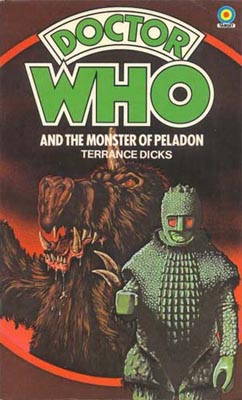The Monster of Peladon
Doctor Who and the Monster of Peladon

|
The Monster of Peladon |
Target novelisation Doctor Who and the Monster of Peladon |

|
| Author | Terrance Dicks |  |
| Published | 1980 | |
| ISBN | 0 426 202132 9 | |
| First Edition Cover | Steve Kyte |
| Back cover blurb: Fifty years after his first visit to Peladon, the Doctor returns to find that Queen Thalira has inherited a troubled kingdom from her father. Membership of the Galactic Federation was expected to bring peace and prosperity to the planet, but the spirit of the sacred monster Aggedor is once more spreading terror and death. The Doctor uncovers a treacherous plot to steal the mineral wealth of Peladon, and is again confronted by his old enemies - the Ice Warriors. |
On manual pilot by Tim Roll-Pickering 12/4/09
The Monster of Peladon is often held up as the case for avoiding direct sequels in Doctor Who, being overlong, cobbled together and failing to evoke the mystery and awe of the story it follows on from. But when given a shorter length and an author with a contemporary reputation for simply converting the camera script into prose form, how does it stand up?
The answer is: surprisingly well. Terrance Dicks seems to do a rather better job at adapting stories from his own era than with others (in fact, I believe he wrote the final scripts), and the page count restriction actually works in Monster's favour. The story now proceeds at a much better pace, with fascinating little asides such as the comment that silver jumpsuits are almost obligatory for technicians throughout the cosmos, whilst the motivations of the various characters becomes stronger and it's easy to overlook the join in the story where a tale of civil war turns into one of unified resistance to occupation.
The original story heavily reflected some of the biggest domestic political issues of its day, but by the time the novelisation came six years later both the mining unions and the European Economic Community had faded from the forefront of political debate, temporarily at least. An obvious parrallel for 1980 that one could look to is the second oil crisis and the political instability surrounding one of the crucial supplies but it's hard to spot Dicks picking up on these.
There are many little touches throughout the tale, as Dicks adds comments to the prose, culminating in a very moving passage as he reflects on the death of Aggedor. However, some of the other deaths are almost brushed over, particularly that of Ortron. In the early part of the story, no attempt is made to paint one Peladonian faction as wrong beyond the individual ambitions of Etis and Ortron. It's interesting to speculate as to what might have happened had Malcolm Hulke novelised the story: would his left-wing views have painted the miners more sympathetically or would he have given balanced coverage to all sides and explored the motivations? Brian Hayles's two novelisations suggest that had he lived to adapt this one as well, it would be close to the televised version and Dicks lives up to this.
Coming from a period when many of the novelisations feel as though the author is on autopilot, Doctor Who and the Monster of Peladon stands out because of the level of care and attention given to the story. The much greater length of time since the printing of Doctor Who and the Curse of Peladon also means that the recycled elements of the earlier story are less obvious than on television where only two years elapsed between them. Because of this, the book stands out as one of the highlights from this era and makes enjoyable a tale that is notoriously turgid on television. 7/10
A Haiku by Finn Clark 14/1/25
Terrance Dicks ain't Hayles.
It's mediocre, frankly.
Ortron's got dumber.